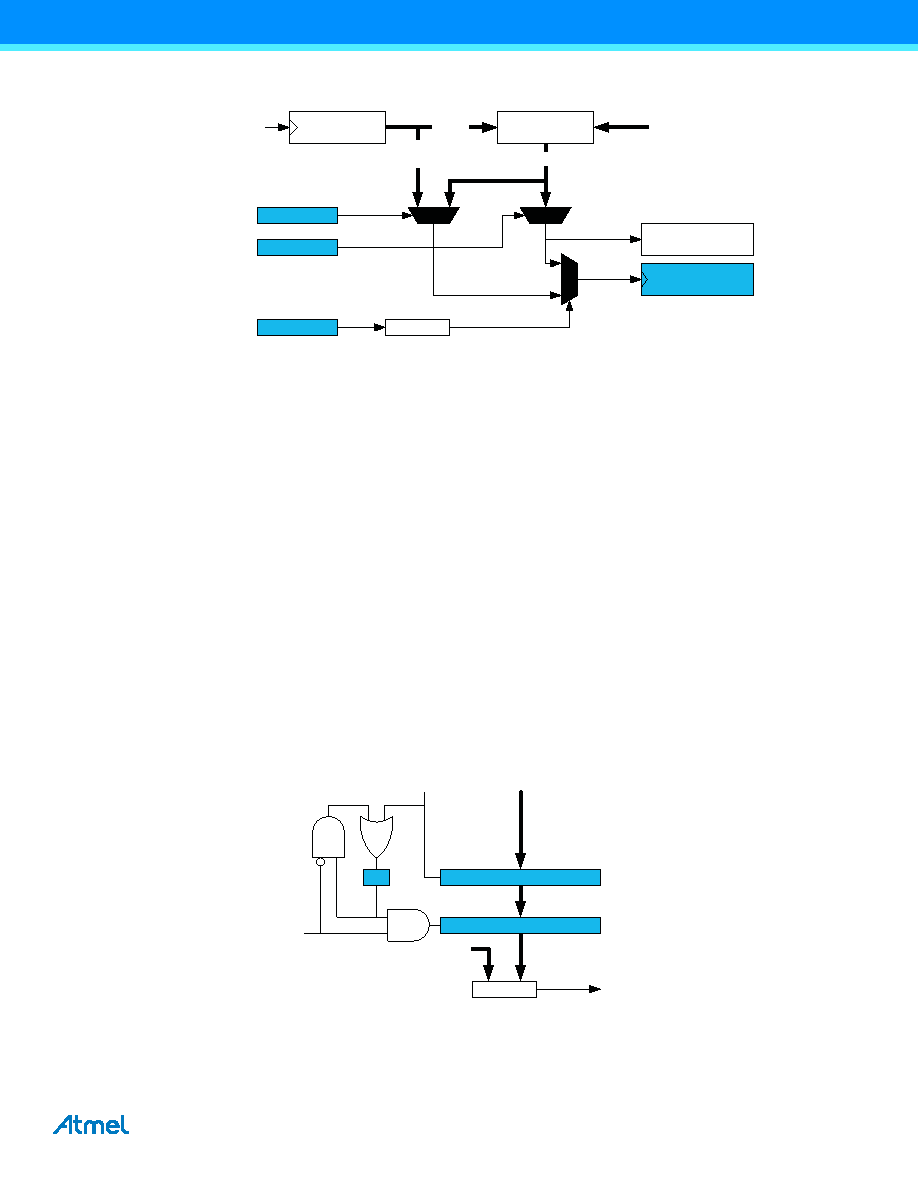- 您现在的位置:买卖IC网 > Sheet目录3854 > PIC18F4450-I/PT (Microchip Technology)IC PIC MCU FLASH 8KX16 44TQFP

154
XMEGA A [MANUAL]
8077I–AVR–11/2012
Figure 14-3. Clock and event selection.
The peripheral clock is fed into a common prescaler (common for all timer/counters in a device). Prescaler outputs from 1
to 1/1024 are directly available for selection by the timer/counter. In addition, the whole range of prescaling from 1 to 215
times is available through the event system.
Clock selection (CLKSEL) selects one of the prescaler outputs directly or an event channel as the counter (CNT) input.
This is referred to as normal operation of the counter. For details, refer to “Normal Operation” on page 155. By using the
event system, any event source, such as an external clock signal on any I/O pin, may be used as the clock input.
In addition, the timer/counter can be controlled via the event system. The event selection (EVSEL) and event action
(EVACT) settings are used to trigger an event action from one or more events. This is referred to as event action
controlled operation of the counter. For details, refer to “Event Action Controlled Operation” on page 155. When event
action controlled operation is used, the clock selection must be set to use an event channel as the counter input.
By default, no clock input is selected and the timer/counter is not running.
14.5
Double Buffering
The period register and the CC registers are all double buffered. Each buffer register has a buffer valid (BV) flag, which
indicates that the buffer register contains a valid, i.e. new, value that can be copied into the corresponding period or CC
register. When the period register and CC channels are used for a compare operation, the buffer valid flag is set when
data is written to the buffer register and cleared on an UPDATE condition. This is shown for a compare register in Figure
Figure 14-4. Period and compare double buffering.
When the CC channels are used for a capture operation, a similar double buffering mechanism is used, but in this case
the buffer valid flag is set on the capture event, as shown in Figure 14-5. For capture, the buffer register and the
clkPER /
2
{0,...,15}
CKSEL
CNT
EVACT
clkPER /
{1,2,4,8,64,256,1024}
Common
Prescaler
clkPER
event channels
(Encoding)
Event System
EVSEL
Control Logic
events
BV
UPDATE
"write enable"
"data write"
=
CNT
"match"
CCxBUF
CCx
EN
发布紧急采购,3分钟左右您将得到回复。
相关PDF资料
21FMN-BMTTR-A-TB
CONN FMN HSNG 21POS STAG REV SMD
PIC16LF87-I/ML
IC MCU FLASH 4KX14 EEPROM 28QFN
PIC24HJ32GP204-I/PT
IC PIC MCU FLASH 32K 44TQFP
20FMN-BMTTR-A-TB
CONN FMN HSNG 20POS STAG REV SMD
PIC16F88-I/SS
IC MCU FLASH 4KX14 EEPROM 20SSOP
18FMN-BMTTR-A-TB
CONN FMN HSNG 18POS STAG REV SMD
17FMN-BMTTR-A-TB
CONN FMN HSNG 17POS STAG REV SMD
PIC18LF46J11-I/ML
IC PIC MCU FLASH 64K 2V 44-QFN
相关代理商/技术参数
PIC18F4450T-I/ML
功能描述:8位微控制器 -MCU 16KB FL 768 RAM 34 I/O FS-USB 2.0 RoHS:否 制造商:Silicon Labs 核心:8051 处理器系列:C8051F39x 数据总线宽度:8 bit 最大时钟频率:50 MHz 程序存储器大小:16 KB 数据 RAM 大小:1 KB 片上 ADC:Yes 工作电源电压:1.8 V to 3.6 V 工作温度范围:- 40 C to + 105 C 封装 / 箱体:QFN-20 安装风格:SMD/SMT
PIC18F4450T-I/PT
功能描述:8位微控制器 -MCU 16KB FL 768 RAM 34 I/O FS-USB 2.0 RoHS:否 制造商:Silicon Labs 核心:8051 处理器系列:C8051F39x 数据总线宽度:8 bit 最大时钟频率:50 MHz 程序存储器大小:16 KB 数据 RAM 大小:1 KB 片上 ADC:Yes 工作电源电压:1.8 V to 3.6 V 工作温度范围:- 40 C to + 105 C 封装 / 箱体:QFN-20 安装风格:SMD/SMT
PIC18F4455-BL
制造商:POWERLITE SYSTEMS 功能描述:PIC18F445 W/ BOOTLOADER FOR FLASHLAB 制造商:POWERLITE SYSTEMS 功能描述:PIC18F445 W/ BOOTLOADER, FOR FLASHLAB 制造商:POWERLITE SYSTEMS 功能描述:PIC18F445 W/ BOOTLOADER, FOR FLASHLAB; Silicon Manufacturer:Powerlite Systems; Core Architecture:PIC; Kit Contents:Board; Features:Bootloader Programming, RS232 Connector for Boot-Loading and Serial Comms ;RoHS Compliant: Yes
PIC18F4455-I/ML
功能描述:8位微控制器 -MCU 24kBF 2048RM FSUSB2 RoHS:否 制造商:Silicon Labs 核心:8051 处理器系列:C8051F39x 数据总线宽度:8 bit 最大时钟频率:50 MHz 程序存储器大小:16 KB 数据 RAM 大小:1 KB 片上 ADC:Yes 工作电源电压:1.8 V to 3.6 V 工作温度范围:- 40 C to + 105 C 封装 / 箱体:QFN-20 安装风格:SMD/SMT
PIC18F4455-I/P
功能描述:8位微控制器 -MCU 24kBF 2048RM FSUSB2 RoHS:否 制造商:Silicon Labs 核心:8051 处理器系列:C8051F39x 数据总线宽度:8 bit 最大时钟频率:50 MHz 程序存储器大小:16 KB 数据 RAM 大小:1 KB 片上 ADC:Yes 工作电源电压:1.8 V to 3.6 V 工作温度范围:- 40 C to + 105 C 封装 / 箱体:QFN-20 安装风格:SMD/SMT
PIC18F4455-I/PT
功能描述:8位微控制器 -MCU 24kBF 2048RM FSUSB2 RoHS:否 制造商:Silicon Labs 核心:8051 处理器系列:C8051F39x 数据总线宽度:8 bit 最大时钟频率:50 MHz 程序存储器大小:16 KB 数据 RAM 大小:1 KB 片上 ADC:Yes 工作电源电压:1.8 V to 3.6 V 工作温度范围:- 40 C to + 105 C 封装 / 箱体:QFN-20 安装风格:SMD/SMT
PIC18F4455T-I/ML
功能描述:8位微控制器 -MCU 24kBF 2048RM FSUSB2 RoHS:否 制造商:Silicon Labs 核心:8051 处理器系列:C8051F39x 数据总线宽度:8 bit 最大时钟频率:50 MHz 程序存储器大小:16 KB 数据 RAM 大小:1 KB 片上 ADC:Yes 工作电源电压:1.8 V to 3.6 V 工作温度范围:- 40 C to + 105 C 封装 / 箱体:QFN-20 安装风格:SMD/SMT
PIC18F4455T-I/PT
功能描述:8位微控制器 -MCU 24kBF 2048RM FSUSB2 RoHS:否 制造商:Silicon Labs 核心:8051 处理器系列:C8051F39x 数据总线宽度:8 bit 最大时钟频率:50 MHz 程序存储器大小:16 KB 数据 RAM 大小:1 KB 片上 ADC:Yes 工作电源电压:1.8 V to 3.6 V 工作温度范围:- 40 C to + 105 C 封装 / 箱体:QFN-20 安装风格:SMD/SMT